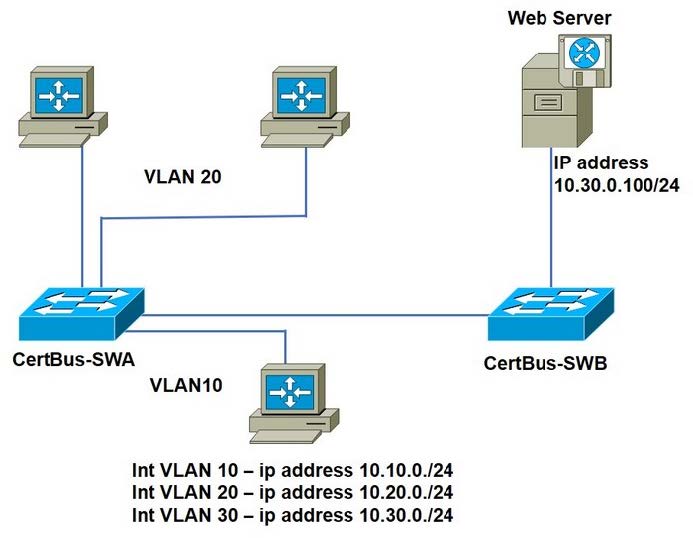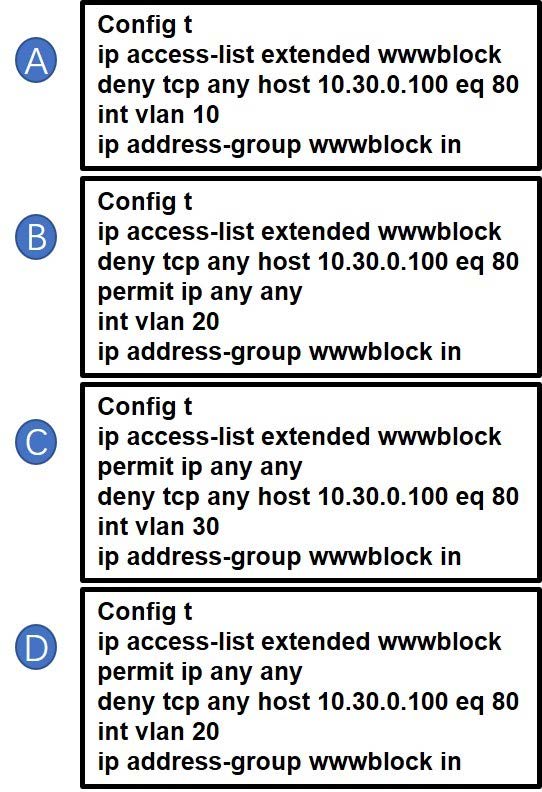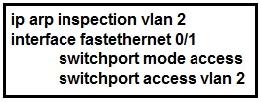Exam Details
Exam Code
:200-301Exam Name
:Implementing and Administering Cisco Solutions (CCNA) (Include Newest Simulation Labs)Certification
:CCNAVendor
:CiscoTotal Questions
:1606 Q&AsLast Updated
:Apr 14, 2025
Cisco CCNA 200-301 Questions & Answers
-
Question 1241:
Which command prevents passwords from being stored in the configuration as plain text on a router or switch?
A. enable secret
B. enable password
C. service password-encryption
D. username cisco password encrypt
-
Question 1242:
Refer to the exhibit.

A network engineer must block access for all computers on VLAN 20 to the web server via HTTP All other computers must be able to access the web server.

Which configuration when applied to switch A accomplishes this task?
A. Option A
B. Option B
C. Option C
D. Option D
-
Question 1243:
Refer to the exhibit.

What is the effect of this configuration?
A. The switch port remains administratively down until the interface is connected to another switch.
B. Dynamic ARP Inspection is disabled because the ARP ACL is missing.
C. The switch port interface trust state becomes untrusted.
D. The switch port remains down until it is configured to trust or untrust incoming packets.
-
Question 1244:
Which command enables a router to become a DHCP client?
A. ip address dhcp
B. ip dhcp client
C. ip helper-address
D. ip dhcp pool
-
Question 1245:
A network engineer must back up 20 network router configurations globally within a customer environment. Which protocol allows the engineer to perform this function using the Cisco IOS MIB?
A. ARP
B. SNMP
C. SMTP
D. CDP
-
Question 1246:
Which two tasks must be performed to configure NTP to a trusted server in client mode on a single network device? (Choose two.)
A. Enable NTP authentication.
B. Verify the time zone.
C. Specify the IP address of the NTP server.
D. Set the NTP server private key.
E. Disable NTP broadcasts.
-
Question 1247:
Which two actions are performed by the Weighted Random Early Detection mechanism? (Choose two.)
A. It supports protocol discovery.
B. It guarantees the delivery of high-priority packets.
C. It can identify different flows with a high level of granularity.
D. It can mitigate congestion by preventing the queue from filling up.
E. It drops lower-priority packets before it drops higher-priority packets.
-
Question 1248:
If a notice-level messaging is sent to a syslog server, which event has occurred?
A. A network device has restarted.
B. A debug operation is running.
C. A routing instance has flapped.
D. An ARP inspection has failed.
-
Question 1249:
Refer to the exhibit.

An engineer configured NAT translations and has verified that the configuration is correct.
Which IP address is the source IP?
A. 10.4.4.4
B. 10.4.4.5
C. 172.23.103.10
D. 172.23.104.4
-
Question 1250:
Refer to the exhibit.

If configuring a static default route on the router with the ip route 0.0.0.0 0.0.0.0 10.13.0.1 120 command, how does the router respond?
A. It starts sending traffic without a specific matching entry in the routing table to GigabitEthernet0/1.
B. It immediately replaces the existing OSPF route in the routing table with the newly configured static route.
C. It starts load-balancing traffic between the two default routes.
D. It ignores the new static route until the existing OSPF default route is removed.
Tips on How to Prepare for the Exams
Nowadays, the certification exams become more and more important and required by more and more enterprises when applying for a job. But how to prepare for the exam effectively? How to prepare for the exam in a short time with less efforts? How to get a ideal result and how to find the most reliable resources? Here on Vcedump.com, you will find all the answers. Vcedump.com provide not only Cisco exam questions, answers and explanations but also complete assistance on your exam preparation and certification application. If you are confused on your 200-301 exam preparations and Cisco certification application, do not hesitate to visit our Vcedump.com to find your solutions here.